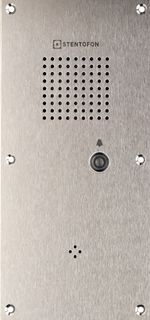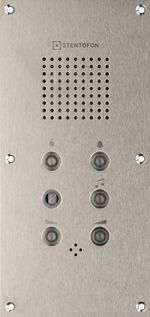Difference between revisions of "PrisCom station - Configuration"
From Zenitel Wiki
(→DAK Keys on physical numbers 500 and 501) |
(→DAK Keys on physical numbers 500 and 501) |
||
| Line 64: | Line 64: | ||
=== DAK Keys on physical numbers 500 and 501 === | === DAK Keys on physical numbers 500 and 501 === | ||
| + | All Priscom stations has common DAK key programming. The DAK configuration is programmed on physical number 500 and 501, and the event handler programming in the PrisCom database will upon reset cause the AlphaCom to automatically program the DAK’s of the Prison Stations to point to these physical numbers 500 and 501. The DAK table of the physical numbers 500 and 501 are preconfigured according to the table below. | ||
| − | + | DAK keys 1-10 is from physical number 500, and DAK key 11-20 is from physical number 501. | |
Revision as of 17:14, 11 December 2012
This article describes how to configure the PrisCom stations 1007061000 and 1007063000.
Contents
Software requirements
- AMC software v.9.09 or later
- AlphaPro 9.21 or later
Configuration starting point
The station properties are programmed from AlphaPro. One can either start with a new AlphaPro database, or one can use a preconfigured AlphaPro database, which includes all neccessary event handler programming for advanced features of the PrisCom stations.
Basic features: Start with a new AlphaPro database and fill in all parameters from scratch.
"Basic features" are:
- Call Button
- Program Step button (without displaying selected channel)
Advanced features: When using the advanced features of the station, it is highly recommended to use a preconfigured AlphaPro database as a starting point. The advanced features is depending on Event Handler programming, and a lot of work is saved by using an already preconfigured database.
"Advanced features" includes support for:
- Light button
- External key switch
- Corridor lamp and/or group lamp
- Display for selected program channel
- Tamper alarm and Power failure
- Scream alarm
- AlphaVision
Basic feature programming
The 7061 and 7063 uses “Two tone DAK signaling", not regular DAK signaling
- In Users & Stations -> User Preferences set DAK signaling to "(3) Two tone signaling w/ack“
- In Users & Stations -> DAK assign numbers to the panel buttons:
- DAK 2 = Call button
- DAK 3 = Program button (not available on the 100 7061 000)
Advanced feature programming
Copy the PrisCom database to the AlphaPro Database folder. Start AlphaPro and select the PrisCom database.
Guard station configuration
- In Users & Stations -> UDP, include the station in UDP 1
- In Users & Stations -> Group, include the station in a “Guard group”. This is required even with a single guard station
Prison station configuration
- In Users & Stations -> UDP, include the station in UDP 2
- In Users & Stations -> UDP, enter the “Guard group” index number in the Used Defined Parameter field. This is the target for calls from this station.
Notes on DAK programming:
- No DAK programming is required
- The event handler programming in the PrisCom database will automatically set “Two tone DAK signaling”, and program the DAK’s to point to physical station 500 and 501
- Physical station 500 and 501 are preconfigured with PrisCom Station DAK keys
Upload to the AlphaCom
- After the PrisCom stations are connected to the AlphaCom, upload the configuration to the AlphaCom by selecting “SendAll” from AlphaPro
- When the upload is finished, reset the AlphaCom. Wait for the exchange to start up, then reset once more. This special dual reset procedure is only required after adding new PrisCom stations to the system.
- Now do a “GetAll” to update AlphaPro with the correct settings
Description of the PrisCom database
The Prison Stations 7061 and 7063 are mainly operating by sending a "Two tone" DAK digits to the exchange for input events, and receiving display data messages in response. These Prison Stations are the only stations types which are using the "double-tone" DAK signalling. The event handler programming in the PrisCom database will automatically set the Prison stations to use “Two tone DAK signaling”.
Display messages are used to e.g. turn lamps on, set alarm preparation mode during guard presence, or control other features. These messages are mostly defined as commands in the AlphaCom event handler. To change functionality one will have to change these commands or add/remove/change events.
DAK Keys on physical numbers 500 and 501
All Priscom stations has common DAK key programming. The DAK configuration is programmed on physical number 500 and 501, and the event handler programming in the PrisCom database will upon reset cause the AlphaCom to automatically program the DAK’s of the Prison Stations to point to these physical numbers 500 and 501. The DAK table of the physical numbers 500 and 501 are preconfigured according to the table below.
DAK keys 1-10 is from physical number 500, and DAK key 11-20 is from physical number 501.
| DAK key | DAK string | Description | |
| 1 | E 9558 | Panelkey 1: Light button | |
| 2 | M I 9550 | Panelkey 2: Call reqest. "Answer" on incoming calls | |
| 3 | I 790 | Panelkey 3: Program button | |
| 4 | E 9551 | Panelkey special: Alarm call | |
| 5 | E 9552 | Tamper switch | |
| 6 | E 9553 | Guard Keysw1 | |
| 7 | E 9554 | Guard Keysw2 | |
| 8 | E 9555 | Guard Reset | |
| 9 | E 9556 | Power fail | |
| 10 | E 9557 | Power OK | |
| 11 | Ext. input 1 ON : (Set as default alarm input during guard presence by display command 0x63. See below) | ||
| 12 | M I 9550 | Ext. input 1 OFF: Ext. Call request. "Answer" on incoming calls | |
| 13 | Ext. input 2 ON | ||
| 14 | Ext. input 2 OFF | ||
| 15 | Ext. input 3 ON | ||
| 16 | Ext. input 3 OFF | ||
| 17 | Ext. input 4 ON | ||
| 18 | Ext. input 4 OFF | ||
| 19 | E 9561 | VOX detector | |
| 20 | |||
IND Commands used by Prison Stations
| IND no | Description | Comment |
| IND 1 | Output 1 (Red lamp) | |
| IND 2 | Output 2 (Green lamp) | |
| IND 3 | Output 3 (Blue lamp) | |
| IND 4 | Output 4 (Group lamp) | |
| IND 5 | Output 5 (Spare) | |
| IND 6 | Output 6 (Spare) | |
| IND 7 | Cell light | |
| IND 8 | Call LED, External LED | Also controlled by microphone active (polarity reveral of C/D-wire during conversation) |
Display commands
| Cmd | Parameters | Default | Description |
| 0x45 | None | Start "silent call" mode. | |
| 0x46 | None | End "silent call" mode. | |
| 0x47 | None | Set flag for preventing call-request button from generating a callrequest in station's offline mode | |
| 0x48 | None | Clear flag for preventing call-request button from generating a callrequest in station's offline mode | |
| 0x60 | ; 00 = off, 01 = on | 60 00 | Set alarm prepare mode on/off. |
| 0x61 | ; 00 = static relay, >00 = pulse length | 61 00 | Select light relay type: Static or pulserelay. |
| 0x62 | ; 00 = none, 01 = type1 | 62 01 | Select offline mode operation type. Required for offline mode operation. |
| 0x63 | 63 02 00 00 00 | Configure general inputs. One byte for each input. Select inverted input (bit0) and alarm-trigger input (bit1) | |
| 0x64 | 64 A0 08 00 14 | Configure VOX detector. Volume level (00=set default), min scream-time (00=set default), max scream-time, min pause before re-enabling alarm. Times in 100ms resolution. (Note: Parameters are not saved to EEPROM, and lost when the station is moved). | |
| 0x65 | 65 0960 | Set guard alarm timeout. Value is 16-bit, 100ms resolution. Max value = 0x199A (11 minutes). | |
| 0x66 | 66 00 | Select front-panel key types: Capacitive sensor-key (0) or switch input (1). Each bit represents one key (bit0 = light-button, bit1 = callrequest, bit2 = program, bit3 = vol up, bit4 = vol dn). | |
| 0x67 | 67 00 0A | Configure keyswitch inputs: Static switches (00) or toggle-switches (01). Delay after activation in 100ms resolution. | |
| 0x68 | 68 06 | Set default volume override level (selected by messages 0x23/0x24). Min=00 Max=06. | |
| 0x70 | None | 70 | Restore EEPROM defaults. |
| 0x71 | TBD | (Software download control-command - not yet used) | |
| 0x72 | TBD | (Software download data-command - not yet used) | |


